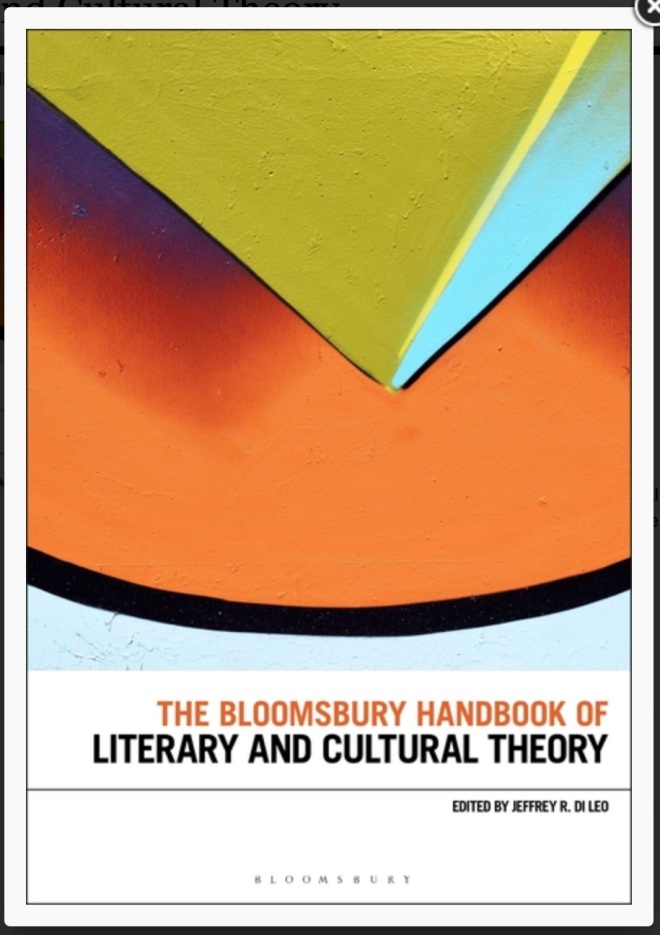
I have an encyclopedia entry on “Seriality” in The Bloomsbury Handbook of Literary and Cultural Theory, which is scheduled to come out this week. I’m not allowed to post the final version, so here is an early version that includes references, bibliography, and a few other details that were cut from the text as it will appear in print.
Seriality
Shane Denson, Stanford University
Seriality is a formal property and/or organizational principle that is commonly associated with ongoing narratives, recurring patterns, and periodic publication schedules. As a narrative form, seriality is perhaps most readily associated today with TV – especially the recent explosion of “narratively complex” (Mittell) television series, which inherit and adapt strategies from 20th-century film and radio serials and popular serialized literature of the 19thcentury. Outside of popular culture, seriality also characterizes a variety of tendencies or “attitudes” (Bochner) in modern art, exemplified by conceptual artists such as Sol LeWitt, Pop artists like Andy Warhol and Roy Lichtenstein, or the twelve-tone music of Arnold Schönberg; in each of these cases, seriality refers less to narrative continuity than to aesthetic modularity and material repetition of visual, acoustic, or other elements. Critical discussions of seriality tend to focus either on popular/narrative or on artistic/non-narrative expressions, thus suggesting a split between “high” and “low” forms; however, there are blurrings and borrowings on both sides: e.g. Pop Art appropriates serialized comics and popular culture generally, while the discontinuous, episodic forms of sitcoms and procedural crime shows embody the modular and quasi-industrial repetition that characterizes so much post-War gallery art. At the root of seriality in all of these forms is an interplay, highlighted by Umberto Eco, between repetition and variation (or innovation).
Seen in terms of this formal interplay, seriality is pervasive across literary and cultural traditions, from the Homeric epics to J.S. Bach’s Goldberg Variations and beyond. However, serial forms have proliferated at an unprecedented rate since the 19thcentury, when technological advances like the steam-powered printing press enabled serialized publication to dominate the literary marketplace. As Roger Hagedorn has argued, 19th-century feuilletons, penny dreadfuls, and dime novels attest to close relations between seriality and media-technical innovation: serialized stories “serve to promote the medium in which they appear” and thus “to develop the commercial exploitation of a specific medium” (5). Moreover, this explosion of serialized culture corresponds to advances in serialized production more generally; the steam engine enabled not only the daily newspaper but also promoted deskilled factory work, leading eventually to the Taylor/Ford assembly line. Thus, both narrative and non-narrative forms of seriality find impetus in industrialization; Eugène Sue and Donald Judd alike owe debts to industrial technologies, which are inextricable from capitalism. According to Karl Marx, capital operates according to serialized processes of its own (not just factory production but the process of repetition and variation expressed abstractly as M-C-M´ chains of value-production). This grounding of modern seriality in industrial capitalism helps explain the suspicion and scorn heaped on the “culture industry” by the likes of Horkheimer and Adorno, but it also points to the necessity to regard seriality not just as a formal property of cultural objects but as a social phenomenon that is central to the contemporary lifeworld: both our collective identities (such as “the nation,” according to Benedict Anderson, or gender for Iris Marion Young) and modern subjectivity itself (in Jean-Paul Sartre’s pessimistic view) can be seen as products and expressions of seriality.
Bibliography:
Anderson, Benedict. “Nationalism, Identity, and the Logic of Seriality.” The Spectre of Comparisons. New York: Verso, 1998.29-45.
Bochner, Mel. “The Serial Attitude.” Artforum 6.4 (December 1967): 28-33.
Eco, Umberto. “Innovation and Repetition: Between Modern and Post-Modern Aesthetics.” Daedelus 114 (1985): 161-184. Rpt. as “Interpreting Serials” in The Limits of Interpretation. Bloomington: Indiana UP, 1990. 83-100.
Hagedorn, Roger. “Technology and Economic Exploitation: The Serial as a Form of Narrative Presentation.” Wide Angle: A Film Quarterly of Theory, Criticism, and Practice 10.4 (1988): 4-12.
Horkheimer, Max and Theodor W. Adorno. “The Culture Industry: Enlightenment as Mass Deception.”Dialectic of Enlightenment: Philosophical Fragments. Ed. Gunzelin Schmid Noerr. Trans. Edmund Jephcott. Stanford: Stanford UP, 2002.
Marx, Karl. Capital, Volume 1. New York: Penguin Classics, 1990.
Mittell, Jason. Complex TV: The Poetics of Contemporary Television Storytelling. New York: New York UP, 2015.
Sartre, Jean-Paul. Critique of Dialectical Reason, Volume One. Trans. Alan Sheridan-Smith. Foreword by Fredric Jameson. New York: Verso, 2004.
Young, Iris Marion. “Gender as Seriality: Thinking about Women as a Social Collective.” Signs: Journal of Women in Culture and Society19.3 (1994): 713-38.
Further Reading:
Allen, Rob and Thijs van den Berg, eds. Serialization in Popular Culture. New York: Routledge, 2014.
Denson, Shane and Andreas Jahn-Sudmann, eds. Digital Seriality. Special issue of Eludamos: Journal for Computer Game Culture 8.1 (2014): <http://www.eludamos.org/index.php/eludamos/issue/view/vol8no1>.
Kelleter, Frank, ed. Media of Serial Narrative. Columbus: Ohio State UP, 2017.